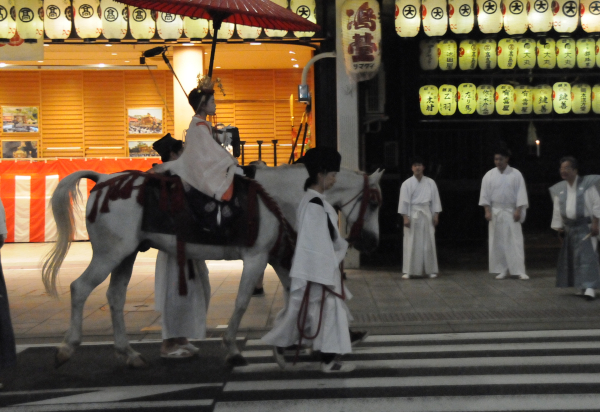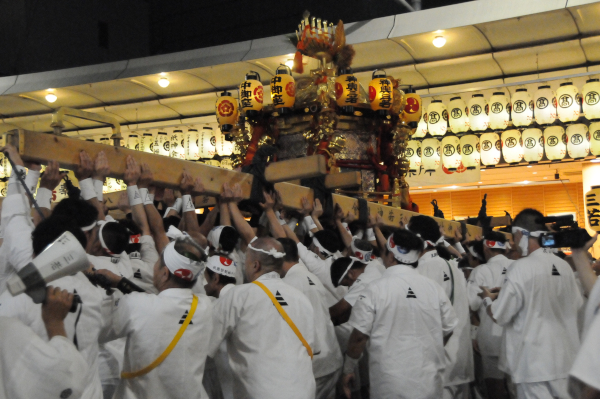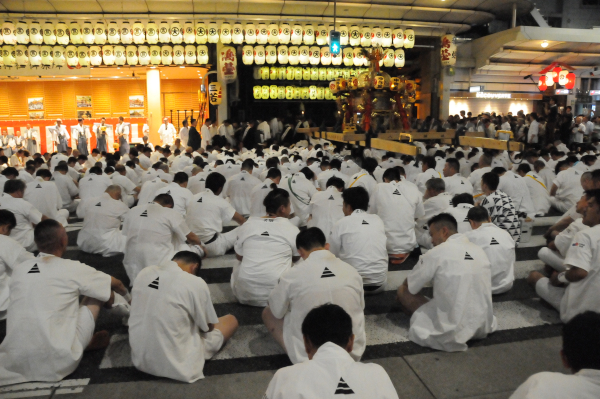I actually made it to the Shinko-sai of Gion Matsuri last night! The Shinko-sai is the first part of Gion Matsuri (or actually, many of the shrine festivals in Kyoto and elsewhere), where first, the gods of Yasaka shrine are moved from their seats in the shrine to the portable mikoshi. Then, the mikoshi are paraded through the neighborhoods by enthusiastic people before they are placed in their temporary resting place, the so-called Otabisho. In Kyoto, the Otabisho for Yasaka Shrine is directly on the corner of Shijo dori and Shinkyogoku dori, which are both very popular shopping streets.
Yesterday, after my meeting, I went down to the Otabisho, where I arrived around 19:30. From 20:00, Shijo dori was closed for traffic (Shinkyogoku is a pedestrian area to begin with), and people were anxiously waiting for something to happen. Around 20:30, a parade arrived with musicians and gifts for the gods and people on horseback accompanying the chigo, a young boy who is representing a god or the gods during the whole of Gion Matsuri. He is the most important figure during Gion Matsuri with special duties and is not allowed to touch the ground or any woman, including his mother, for example.
 About 45 minutes later, the first of three mikoshi arrived. In front was a group of children, all dressed up like the adults, and all happily yelling hotoi to cheer on those who would carry the mikoshi behind them.
About 45 minutes later, the first of three mikoshi arrived. In front was a group of children, all dressed up like the adults, and all happily yelling hotoi to cheer on those who would carry the mikoshi behind them.
 Then, finally, the first mikoshi arrived, accompanied by over 100 people who carried it on their shoulders. And, as if this portable shrine was not heavy enough as it is, it is very important to jump up and down with it, accompanied by shouts of hotoi throughout. The jumping looks almost choreographed with special steps, and the men carrying the mikoshi are changing all the time, which is also done very carefully.
Then, finally, the first mikoshi arrived, accompanied by over 100 people who carried it on their shoulders. And, as if this portable shrine was not heavy enough as it is, it is very important to jump up and down with it, accompanied by shouts of hotoi throughout. The jumping looks almost choreographed with special steps, and the men carrying the mikoshi are changing all the time, which is also done very carefully.
 In the end, the mikoshi made two full turns in front of the Otabisho on outstretched hands, which is quite a feat.
In the end, the mikoshi made two full turns in front of the Otabisho on outstretched hands, which is quite a feat.
 Finally, the mikoshi was set down in front of the shrine next to the Otabisho. There, prayers were said – probably to welcome the kami to its resting place – and finally, everybody clapped happily for a job well done.
Finally, the mikoshi was set down in front of the shrine next to the Otabisho. There, prayers were said – probably to welcome the kami to its resting place – and finally, everybody clapped happily for a job well done.
 While the first mikoshi was dismantled and put up in the Otabisho, the second one already waited a bit further down Shijo dori, but by now it was 22:00, and to be very honest, after more than 2 hours of standing on the hot asphalt, my feet hurt quite a bit. So I decided to go home, leaving the clapping and shouting for the other two mikoshi to the remaining spectators. Interestingly, also the men who carried the first shrine did not stick around. On my way back to my bicycle, I could see them walking home in small groups, obviously even more exhausted than me.
While the first mikoshi was dismantled and put up in the Otabisho, the second one already waited a bit further down Shijo dori, but by now it was 22:00, and to be very honest, after more than 2 hours of standing on the hot asphalt, my feet hurt quite a bit. So I decided to go home, leaving the clapping and shouting for the other two mikoshi to the remaining spectators. Interestingly, also the men who carried the first shrine did not stick around. On my way back to my bicycle, I could see them walking home in small groups, obviously even more exhausted than me.
